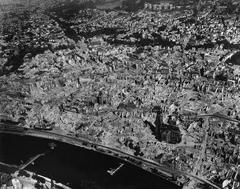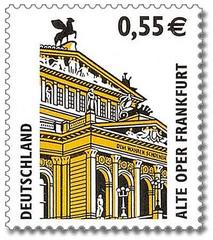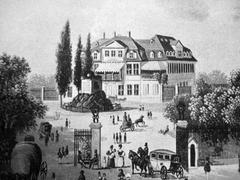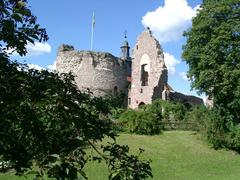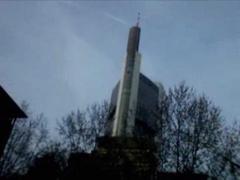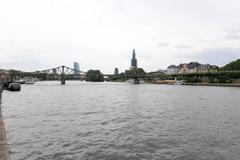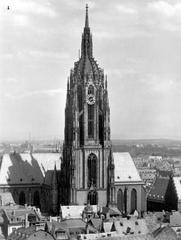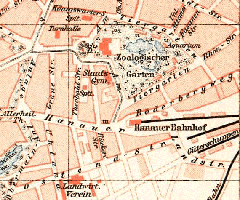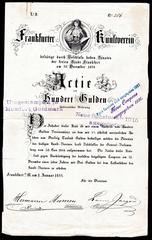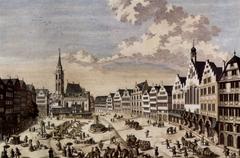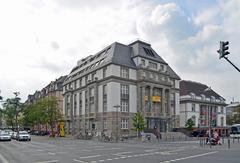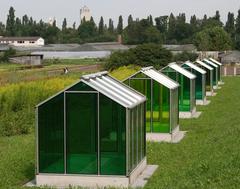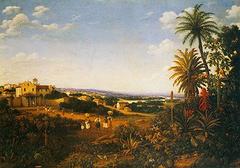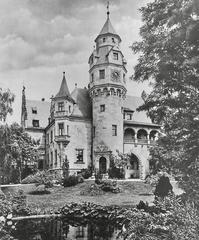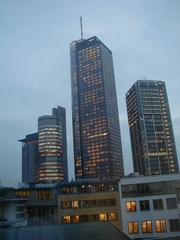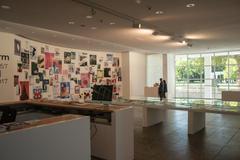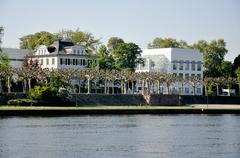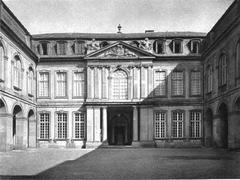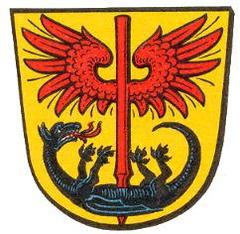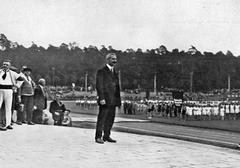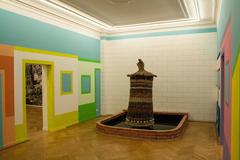
Comprehensive Guide to Visiting Frankfurt, Darmstadt Government Region, Germany
Date: 29/07/2024
Captivating Introduction
Imagine a city where medieval charm dances with modern skyscrapers, where the scent of freshly baked pretzels mingles with the crispness of Apfelwein, and where every cobblestone whispers tales of emperors and poets. Welcome to Frankfurt, a city that has been a melting pot of history, culture, and innovation since the days of the Roman Empire. Nestled in the Darmstadt Government Region of Germany, Frankfurt is not just a financial powerhouse but a vibrant tapestry of old-world elegance and cutting-edge modernity. Whether you’re a history buff, a foodie, or an intrepid explorer, Frankfurt offers a kaleidoscope of experiences that promise to captivate your senses and ignite your imagination. From the medieval Römerberg square to the towering Main Tower, and from the bustling Kleinmarkthalle to the serene Frankfurt City Forest, this city invites you to uncover its secrets and revel in its stories. So, grab your Frankfurt Card for unlimited travel and discounts, and let’s dive into this captivating metropolis where every corner holds a surprise, and every experience is a memory waiting to be made. Ready for an adventure? Let’s go! (Wikipedia, The World Was Here First, Visit Frankfurt).
Table of Contents
- Historical Overview
- Unveiling Frankfurt: A City of History and Surprises
- Early Beginnings and Medieval Growth
- The Thirty Years’ War and the Peace of Westphalia
- The French Revolutionary Wars and the Grand Duchy of Frankfurt
- Industrialization and Political Changes in the 19th Century
- The Early 20th Century and World War II
- Post-War Reconstruction and Modern Development
- Cultural and Architectural Highlights
- Modern Frankfurt: A Blend of Old and New
- Visitor Tips for Exploring Frankfurt’s History
- Visitor Tips for Frankfurt, Darmstadt Government Region, Germany
- Top Attractions in Frankfurt
- Welcome to Frankfurt
- Römerberg
- Städel Museum
- Frankfurt Cathedral (Dom)
- Kleinmarkthalle
- Main Tower
- Goethe House
- Frankfurt City Forest
- Frankfurt Book Fair
- Historisches Museum
- Rüdesheim am Rhein
- Offenbach
- Frankfurt Stock Exchange
- Senckenberg Natural History Museum
- Liebieghaus Museum of Sculpture
- Frankfurt Zoological Garden
- Tips for Visitors
Historical Overview of Frankfurt, Darmstadt Government Region, Germany
Unveiling Frankfurt: A City of History and Surprises
Ever wondered how a city could seamlessly blend medieval charm with modern skyscrapers? Welcome to Frankfurt, a city that’s been breaking molds since the Roman Empire! Imagine a bustling metropolis where the past and present dance together in a captivating waltz. Ready to dive in? Let’s go!
Early Beginnings and Medieval Growth
Picture this: It’s 794 AD, and Charlemagne himself is holding a synod in a place that will later become Frankfurt. That’s right, folks, Frankfurt’s roots dig deep into the Roman Empire. By the 12th century, this place was booming, earning its stripes as a free imperial city under the Hohenstaufen emperors. This meant self-governance and electing officials – pretty progressive for medieval times, huh? (Wikipedia).
The Thirty Years’ War and the Peace of Westphalia
Fast forward to the 17th century, a time of chaos and conflict. While Europe was caught in the whirlwind of the Thirty Years’ War, Frankfurt played it smart, maintaining neutrality. It wasn’t all smooth sailing though; the plague didn’t spare the city. But guess what? The Peace of Westphalia in 1648 confirmed Frankfurt’s status as an Imperial Free City, ushering in prosperity and growth (Wikipedia).
The French Revolutionary Wars and the Grand Duchy of Frankfurt
Hold onto your hats – the French Revolutionary Wars shook things up big time! In 1792, General Custine occupied the city, only for it to be retaken later that year. By 1806, General Augereau and his 9,000 men were extorting 4 million francs from Frankfurt. Talk about a rollercoaster! And just like that, Frankfurt’s free city status was history, becoming the Grand Duchy of Frankfurt under Karl Theodor Anton Maria von Dalberg by 1810 (Wikipedia).
Industrialization and Political Changes in the 19th Century
The 19th century saw Frankfurt transforming like never before. Think industrial laws, freedom of trade, and the political emancipation of Jews by 1864. The city even hosted a political gathering in 1863 aimed at German federal reform. Although it didn’t quite pan out, leading to the Austro-Prussian War in 1866, it marked Frankfurt’s annexation by Prussia and its new identity as part of Hesse-Nassau (Wikipedia).
The Early 20th Century and World War II
The early 20th century was a period of growth and modernization. But World War II brought its share of challenges. Frankfurt faced heavy bombardments and significant destruction. By late March 1945, the city was in the hands of Allied forces, with the US 5th Infantry Division securing it by March 29, 1945 (Wikipedia).
Post-War Reconstruction and Modern Development
Post-war Frankfurt was all about rebuilding and reinventing itself. The IG Farben Building, left unscathed by wartime bombardments, became the headquarters for the US Military Governor and later the US High Commissioner for Germany. Despite not being the capital of West Germany, Frankfurt rose as a financial powerhouse, taking on roles previously filled by Berlin and Leipzig (Wikipedia).
Cultural and Architectural Highlights
Frankfurt is a treasure trove of cultural and architectural gems. The Alte Oper, reconstructed after its destruction in 1944, is a testament to the city’s resilience (The World Was Here First). The Goethe-House, birthplace of Johann Wolfgang von Goethe, offers a peek into the life of one of Germany’s literary legends (Visit Frankfurt).
The Römer, Frankfurt’s historical town hall, has been the seat of government since the 15th century. It’s a must-visit for political history enthusiasts (Visit Frankfurt).
Modern Frankfurt: A Blend of Old and New
Today’s Frankfurt is a dynamic blend of the old and new. The Main Tower offers panoramic views, while the European Central Bank headquarters symbolizes the city’s economic strength (Visit Frankfurt). The New Old Town, a reconstruction of the medieval city center, showcases the city’s dedication to preserving its historical identity (Visit Frankfurt).
Frankfurt’s Museumsufer, or Museum Embankment, is a cultural haven with numerous museums, including the Städel Museum, home to an extensive collection of European art (Visit Frankfurt).
Visitor Tips for Exploring Frankfurt’s History
Ready to explore? Here are some nifty tips:
- Public Transportation: Frankfurt’s transit system is top-notch. Grab a Frankfurt Card for unlimited rides and discounts at various attractions (The World Was Here First).
- Museum Visits: On the last Saturday of every month, kids under 18 enjoy free admission to many museums – it’s called ‘SaTOURday’ (Time Out).
- Historical Sites: Don’t miss Paulskirche, where Germany’s first parliament met in 1848, or the Kaiserdom St. Bartholomäus, a Gothic cathedral with roots in the 14th century (Visit Frankfurt).
To truly grasp Frankfurt’s essence, download Audiala, the tour guide app. It offers beautifully crafted audio guides that delve deep yet stay concise. Happy exploring!
Visitor Tips for Frankfurt, Darmstadt Government Region, Germany
When to Visit: The Seasons of Soul
Frankfurt pulses with energy year-round, but the magic truly unfolds in spring (April to June) and autumn (September to November). Picture this: blooming cherry blossoms framing the skyline in spring, while autumn wraps the city in a golden, cozy embrace. Don’t miss the Main Festival in August—a whirlwind of traditional rides, tantalizing regional foods, and cultural spectacles. Football fans, mark your calendars for UEFA EURO 2024, where the excitement spills from Deutsche Bank Park into a 1.4-kilometer-long Fan Zone along the River Main.
Navigating the Urban Jungle
Frankfurt’s public transportation is your trusty steed—efficient and reliable. Grab a Frankfurt Card for unlimited travel and sweet discounts on attractions. Heading to Darmstadt? The Darmstadt Card is your golden ticket for free city transport and perks at museums and tours.
Where to Rest Your Head
From opulent luxury to budget-friendly havens, Frankfurt’s got you covered. Indulge in the plush comforts of Jumeirah Frankfurt or the iconic Steigenberger Frankfurter Hof. Backpackers, check out the lively Five Elements Hostel or the cozy A&O Frankfurt Galluswarte.
A Culinary Odyssey
Frankfurt’s food scene is a melting pot of flavors. Savor the tangy delight of Grüne Soße (green sauce) or the zingy Handkäse mit Musik (cheese with onions and vinegar). For a sensory overload, stroll through the Kleinmarkthalle—an indoor market buzzing with local and international treats. Sip on Apfelwein (apple wine) at traditional taverns like Atschel in Sachsenhausen, where every sip tells a story.
Cultural Treasures
Step into a living museum at the Römerberg, with its medieval square and historic Römer (City Hall). Art lovers will find paradise at the Städel Museum, home to masterpieces spanning seven centuries. For an offbeat adventure, the DialogMuseum offers tours in complete darkness, guided by visually impaired individuals—an eye-opening experience!
Shopper’s Paradise
Retail therapy awaits on the Zeil, Frankfurt’s bustling shopping street. For a touch of luxury, stroll down Goethestraße with its high-end boutiques. Treasure hunters, don’t miss the Flea Market along the River Main every Saturday.
Festivals and Fun
Frankfurt knows how to throw a party. Experience the enchantment of the Christmas Market—one of Germany’s oldest, complete with festive stalls and an ice rink. Wine connoisseurs, the Rheingau Wine Festival in September is a must, offering exquisite tastings and culinary delights. Jazz enthusiasts, swing by Jazz on the Third every third Thursday of the month for soulful rhythms.
Day Trips: Beyond the City
Use Frankfurt as your springboard to explore the enchanting Bergstrasse route from Darmstadt to Heidelberg, dotted with historic castles. Nature lovers, the Odenwald region offers breathtaking hikes and bike trails. For a prehistoric adventure, visit the Messel Pit Fossil Site, a UNESCO World Heritage site brimming with ancient fossils.
Safety and Savvy Tips
Frankfurt is a safe city, but keep your wits about you in crowded areas. The Frankfurt Tourist+Congress Board is your go-to for practical info. In an emergency, dial 112 for medical help and 110 for police assistance.
Access for All
Frankfurt champions accessibility. Attractions like the Senckenberg Naturmuseum have facilities for visitors with disabilities. Public transport is wheelchair-friendly, and the Darmstadt Card includes special tours for people with mobility, visual, or hearing impairments.
Mind Your Manners
In Germany, punctuality is a virtue, and efficiency is king. On public transport, offer your seat to the elderly or disabled. Tipping isn’t mandatory but appreciated; rounding up or leaving a 5-10% tip is standard. A few German phrases can work wonders—try a friendly “Danke!” (thank you) or “Guten Tag!” (good day).
Stay Connected
Stay in the loop with free Wi-Fi at many public spots, including Frankfurt Airport. For mobile data, snag a local SIM from providers like Telekom or Vodafone. Most hotels and cafes also offer free Wi-Fi.
Your Adventure Awaits
Ready to plunge into the heart of Frankfurt and Darmstadt? Let Audiala be your guide. Download the app for an immersive, interactive tour experience, packed with insider tips and hidden gems. Your adventure starts now!
Top Attractions in Frankfurt
Welcome to Frankfurt
Welcome to Frankfurt, a city where modern skyscrapers kiss the clouds while cobblestone streets whisper tales of yore. Imagine sipping on a crisp apple cider as the melody of street musicians fills the air, and the scent of freshly baked pretzels tickles your nose. This is Frankfurt, a city that seamlessly blends the old and new. Ready for an adventure? Let’s dive in and uncover the hidden gems and local secrets of this fascinating metropolis!
Römerberg
Römerberg is the historical heart of Frankfurt, featuring a picturesque square surrounded by half-timbered buildings dating back to the 14th and 15th centuries. Although many of these buildings were destroyed during World War II, they have been meticulously restored to their former glory. The square is home to the Römer, Frankfurt’s city hall, which has been the site of the Holy Roman Emperor’s coronation ceremonies. Visitors can also explore the nearby Historisches Museum, which offers interactive exhibits on the city’s past, including a model showing the extent of the destruction during World War II. And here’s a fun challenge: see if you can count all the half-timbered buildings in the square! (Time Out).
Städel Museum
The Städel Museum is one of Germany’s oldest museum foundations, boasting a collection that spans 700 years of European art. Located in the Museumsufer (Museum Embankment) area, the museum houses over 3,000 paintings, 4,000 photographs, 600 sculptures, and 10,000 drawings. Notable works include pieces by Monet, Picasso, and Andy Warhol. The museum’s contemporary works are displayed in a spacious underground extension, which cost €52 million to build. Admission is 16 EUR, and visitors can download a free app for information on roughly 100 artworks. While exploring, why not play ‘spot the Monet’? (Nomadic Matt).
Frankfurt Cathedral (Dom)
Frankfurt Cathedral, also known as the Dom, is a Gothic masterpiece dating back to the 14th century. The cathedral was historically significant as the site where emperors of the Holy Roman Empire were crowned. Its 95-meter-tall Gothic tower offers panoramic views of the city, accessible via 328 steps—think of it as your workout with a view! Admission to the cathedral is free, but climbing the tower costs 3 EUR. And here’s a tip: greet locals with a friendly ‘Guten Tag’ as you catch your breath at the top (Nomadic Matt).
Kleinmarkthalle
Kleinmarkthalle is a vibrant two-story market hall that offers a unique culinary experience. The market features a wide array of high-quality fresh produce, delicatessen items, and international favorites. It is a popular spot for locals and tourists alike, especially on Saturdays. The market also has various small eateries offering seafood, Italian specialties, and regional German dishes like Handkäse and Wurst. The Marktstubb café on the first floor serves hearty regional dishes. Challenge: find the stall with the best apple cider and tell us about it! ([Time Out### Main Tower
For the best views of Frankfurt, head to the Main Tower, the only high-rise building in the city open to the public. Named after the Main River, the 56-story tower features an observation deck that offers stunning views of the city’s skyline. Tickets to the observation deck cost 9 EUR, and the experience is well worth it for the panoramic vistas. Fun fact: see if you can spot the Römerberg from up here! (Nomadic Matt).
Goethe House
The Goethe House is the birthplace of Johann Wolfgang von Goethe, one of Germany’s most famous writers. Although the original house was destroyed during World War II, it has been meticulously restored. The adjacent Goethe Museum and Library offer insights into the life and works of Goethe, making it a must-visit for literature enthusiasts. Here’s a quirky quest: find Goethe’s favorite writing spot! (Britannica).
Frankfurt City Forest
The Frankfurt City Forest is the largest forest contained within any city limits in Germany. It features six playgrounds, nine ponds, and a 450-kilometer-long network of trails for hikers, walkers, cyclists, and runners. The forest is a popular spot for locals looking to relax in nature and offers a peaceful escape from the bustling city. Pro tip: pack a picnic and enjoy a tranquil afternoon by one of the ponds (Nomadic Matt).
Frankfurt Book Fair
Held annually in mid-October, the Frankfurt Book Fair is the largest event in the publishing industry. The fair attracts publishers, writers, and creative professionals from around the world for discussions, networking, and celebrating the written word. The event lasts a week, but it is only open to the public during the last two days. A day pass costs 25 EUR. Secret tip: some authors do impromptu readings—keep an ear out! (Nomadic Matt).
Historisches Museum
The Historisches Museum offers a deep dive into Frankfurt’s history with hours of interactive exhibits. One of the highlights is a model showing how much of the city center was flattened during World War II. The museum also features exhibits on the Main River and a city model based on input from over 1,000 locals. Admission is free every last Saturday of the month, except in August and December. Insider’s challenge: find the oldest artifact in the museum! (Time Out).
Rüdesheim am Rhein
A popular day trip from Frankfurt is to Rüdesheim am Rhein, located in the nearby Rhine Valley. Known for its vineyards and fairy-tale architecture, Rüdesheim is a charming town that offers wine tastings and picturesque views. It is an excellent destination for those looking to explore the scenic beauty of the Rhine Valley. Fun quest: try the local Riesling and find your favorite vineyard! (Road Affair).
Offenbach
Offenbach is a small neighboring city that offers a slower pace of life compared to Frankfurt. It features numerous shops, a flea market, a farmer’s market, and historical sites like the old baroque castle and the Neo-baroque Büsing Palace. Offenbach is an ideal destination for a day trip to escape the hustle and bustle of Frankfurt. Secret tip: the flea market has some hidden treasures—happy hunting! (Nomadic Matt).
Frankfurt Stock Exchange
The Frankfurt Stock Exchange is one of the world’s largest stock exchanges and a symbol of the city’s financial prowess. Visitors can take guided tours to learn about the history and functioning of the stock exchange. The building itself is an architectural marvel, blending modern design with historical elements. Pro tip: wear your best business attire if you want to blend in with the traders! (Time Out).
Senckenberg Natural History Museum
The Senckenberg Natural History Museum is one of the largest natural history museums in Germany. It features extensive exhibits on biodiversity, paleontology, and geology. Highlights include dinosaur skeletons, a vast collection of fossils, and interactive displays that are both educational and entertaining for visitors of all ages. Fun fact: the museum has the largest dinosaur exhibit in Europe! (Britannica).
Liebieghaus Museum of Sculpture
The Liebieghaus Museum of Sculpture is housed in a 19th-century villa and features an impressive collection of sculptures from ancient Egypt, Greece, and Rome, as well as medieval, Renaissance, and Baroque periods. The museum’s serene garden setting adds to the charm, making it a perfect spot for art lovers. Secret tip: the garden is a great spot for a serene afternoon read (Britannica).
Frankfurt Zoological Garden
The Frankfurt Zoological Garden is one of Germany’s finest zoos, home to a diverse range of animals from around the world. The zoo focuses on conservation and education, offering various programs and exhibits that highlight the importance of wildlife preservation. It is a great destination for families and animal enthusiasts. Fun activity: join a feeding session and watch the animals up close! (Britannica).
Tips for Visitors
- Frankfurt Card: Purchase the Frankfurt Card for free public transportation and discounts at museums, city tours, restaurants, and more. (Road Affair).
- Best Time to Visit: The best time to visit Frankfurt is during the spring (April to June) and fall (September to October) when the weather is pleasant, and the city hosts various festivals and events.
- Accommodation: Hostel prices range from 22-38 EUR per night for dorms, while a basic double private room costs about 160 EUR per night. Some hostels offer breakfast buffets for an additional fee. Pro tip: book early during trade fairs! (Nomadic Matt).
- Dining: Don’t miss dining at one of Frankfurt’s famous cider houses or relaxing at a beer garden. The city offers a diverse culinary scene with options ranging from traditional German dishes to international cuisine. Insider tip: try the local ‘Grüne Soße’—it’s a herb sauce that’s a local favorite! (Nomadic Matt).
By exploring these top attractions and following these tips, visitors can make the most of their time in Frankfurt and experience the rich history, culture, and modern vibrancy of this fascinating city. And for an even more immersive experience, don’t forget to download the Audiala app to guide you through the city’s hidden gems and local secrets!
Call to Action
As we draw our journey through Frankfurt to a close, it’s clear that this city is much more than a financial hub; it’s a living museum, a cultural melting pot, and a gateway to both the past and the future. Whether you’ve marveled at the Gothic spires of the Frankfurt Cathedral, wandered through the historical Römerberg, or immersed yourself in the vibrant atmosphere of the Kleinmarkthalle, each experience in Frankfurt is a chapter in a never-ending story of resilience, innovation, and charm. The city’s unique blend of medieval and modern, its commitment to preserving history while embracing progress, and its rich tapestry of cultural and culinary delights make it a must-visit destination for any traveler. And remember, your adventure doesn’t end here. With the Audiala app, you can continue to explore Frankfurt’s hidden gems, uncover its secrets, and experience its stories like never before. So, download Audiala, the ultimate tour guide app, and let it be your companion as you delve deeper into the heart of Frankfurt. Your next adventure awaits – are you ready to unlock the city’s secrets? (Nomadic Matt, Time Out, Britannica).
References
- Wikipedia. (n.d.). History of Frankfurt am Main. Wikipedia
- The World Was Here First. (n.d.). Frankfurt Itinerary. The World Was Here First
- Visit Frankfurt. (n.d.). Experience Attractions Top 10. Visit Frankfurt
- Nomadic Matt. (n.d.). Travel Guides, Germany Travel Tips, Frankfurt. Nomadic Matt
- Time Out. (n.d.). Best Attractions in Frankfurt. Time Out
- Britannica. (n.d.). Frankfurt am Main. Britannica
- Road Affair. (n.d.). 1 Day in Frankfurt Itinerary. Road Affair
- Frankfurt Tourism. (n.d.). Main Festival. Frankfurt Tourism







